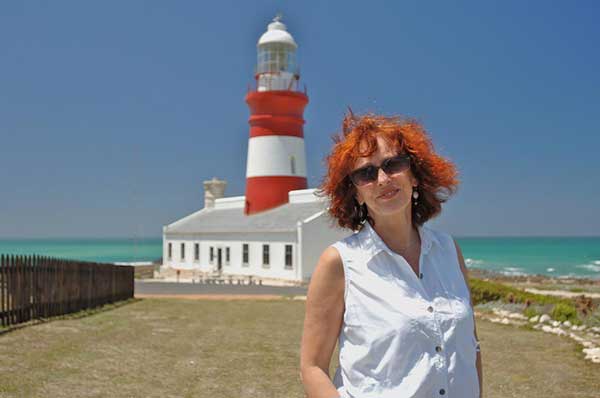Travel Articles
Return To Full List of Travel Articles
The The Garden Route |
Mail on Sunday Travel, August 2007 |
I know you're not supposed to swallow every mouthful of wine at a tasting but believe me, in the wineries of South Africa's Cape, it's hard not to glug. Even after breakfast. We were at the Flagstone Winery, at Somerset West, just outside Cape Town. This was our first day driving along South Africa's glorious southern coast, and it was proving hard to tear me away from Wilhelm 'Red' Coetzee, cellar master extraordinaire, who kept offering yet another glass of nectar. When he brought out a Pinotage called 'Writer's Block' and invited me to savour 'aromas of wild blueberry and ripe cherry' I decided I wanted to marry the guy. What writer could possibly have a block when inspired by South Africa's finest – I mean, men as well as wine?
My sober partner dragged me away, and we headed inland for Stellenbosch, at the heart of the winelands. This area is dramatically beautiful: cloud-capped mountains towering over valleys of neat vineyards, and lovely towns, which show their Cape Dutch and English Victorian heritage. The sky was lowering, but thanks to the Flagstaff wine I was cheerful and said it showed the white gables off to good advantage. After a late lunch and some shopping, we continued to our first stop, Franschoek – literally 'French Hook,' indicating its history. This exquisite, white town has just one main street, and we found our hotel 'Le Quartier Francais' easily. This was to be a busy time because we had another week planned in Cape Town itself, and yet I'd decided that two nights in any hotel at least gives you time to settle and get a sense of place.
But after the sublime gourmet dinner in the hotel's famous restaurant 'The Tasting Room' we decided we could stay there a week. The hotel is superb; accommodation in small 'cottages' with fireplaces around a flowery central courtyard swimming pool, and a standard of service, which is (we were to discover) typical of this country, which, with so many economic problems, knows how much it needs its tourist, trade. And for those who think that a town like Franschoek is a little too twee, too tourist-centred with its chic shops, you can take a short drive through stunning scenery to Paarl, where black traders lined the streets selling everything from saucepans to suitcases, and the atmosphere was friendly and 'real.' For a few rand I bought the necessary roll bag for all the purchases to come. Paarl's real claim to fame (or notoriety) is that it is where, on 11th February 1990, Nelson Mandela ended his 27 years in captivity, walking out from the prison.
I decided we should toast him, so back in pretty Franschoek we went to another winery, this one called Grand Provence – which was as grand (yet still friendly) as you could imagine. There's a tasting room, and a wonderful restaurant – just in case you need some food to mop up the wine. And outside the vines stretch in rows as far as you can see. You can actually stay there, in the superb 'owner's cottage,' but you'd come home a couple of stone heavier.
After two nights at Le Quartier Francais the coast beckoned, and so we drove in a loop through the mountain scenery of the Overberg towards Hermanus. If this route was wild and awe-inspiring it became even more beautiful when you could see the ocean too – bowling along the coast road with the mountains on your left, and white capped waves on the other side, under an exhilarating blue sky.
We drove through Hermanus, knowing we'd be back to watch whales, because it was time to find the next 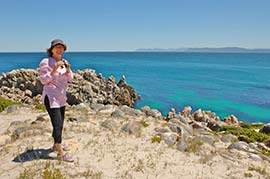 hotel. Near Stanford, the Blue Gum Country Estate was hard to find, but so worth it. Now a long, rutted track the old house lies beneath a small mountain, but there is nothing rustic or primitive about the rooms. We had a huge one, with a double-ended bath within it, an open fire, sofa, and terrace looking out onto the 'fynbos' (literally 'fine bush') – which simply means rich natural terrain of wildflowers, grasses etc. We wasted no time in taking the winding trail around the lower slopes of the mountain – surprising a baboon and a duiker (like a springbok) and observing a sleepy snake by the path. Wild cries of crows split the air. It was quietly thrilling. And that night the Blue Gum Lodge lost its electricity for a while, so we ate a delicious dinner in a romantic dining room lit entirely by candles. It was almost disappointing when the power came back.
hotel. Near Stanford, the Blue Gum Country Estate was hard to find, but so worth it. Now a long, rutted track the old house lies beneath a small mountain, but there is nothing rustic or primitive about the rooms. We had a huge one, with a double-ended bath within it, an open fire, sofa, and terrace looking out onto the 'fynbos' (literally 'fine bush') – which simply means rich natural terrain of wildflowers, grasses etc. We wasted no time in taking the winding trail around the lower slopes of the mountain – surprising a baboon and a duiker (like a springbok) and observing a sleepy snake by the path. Wild cries of crows split the air. It was quietly thrilling. And that night the Blue Gum Lodge lost its electricity for a while, so we ate a delicious dinner in a romantic dining room lit entirely by candles. It was almost disappointing when the power came back.
People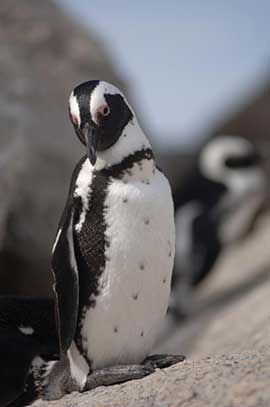 flock to this part of the coast to go whale-watching, following instructions to go outside popular Hermanus. We waited by a sparkling bay, grew restive – and then suddenly there they were: a huge Mama and her calf, basking in the sunlight, close to the shore. On trips like this you expect to be able to see some of out fellow inhabitants of the planet, but it is no less exciting when you do. In a strange way too, I feel that the tourism that has grown up around such activities as whale watching is only good – for two reasons. A town like Hermanus thrives on tourism and the tourists themselves can only be reminded of the need to respect the natural world. Later the owner of the Blue Gum, Nic Rhodes was to remind us yet again that tourism – properly and justly organised - may be one of the routes to salvation for this 'rainbow country' with so many social problems. He trains all his staff (like lovely 18 year old Gloria who began washing dishes and has progressed to waitressing, because her English is good enough) and is prepared now to sell 25% of the business to the staff who are prepared to take the responsibility. He spoke of the need to 'bring up' the people and said, 'Unless we white South Africans who love this country help them, then we will have no country.'
flock to this part of the coast to go whale-watching, following instructions to go outside popular Hermanus. We waited by a sparkling bay, grew restive – and then suddenly there they were: a huge Mama and her calf, basking in the sunlight, close to the shore. On trips like this you expect to be able to see some of out fellow inhabitants of the planet, but it is no less exciting when you do. In a strange way too, I feel that the tourism that has grown up around such activities as whale watching is only good – for two reasons. A town like Hermanus thrives on tourism and the tourists themselves can only be reminded of the need to respect the natural world. Later the owner of the Blue Gum, Nic Rhodes was to remind us yet again that tourism – properly and justly organised - may be one of the routes to salvation for this 'rainbow country' with so many social problems. He trains all his staff (like lovely 18 year old Gloria who began washing dishes and has progressed to waitressing, because her English is good enough) and is prepared now to sell 25% of the business to the staff who are prepared to take the responsibility. He spoke of the need to 'bring up' the people and said, 'Unless we white South Africans who love this country help them, then we will have no country.'
It was hard to leave Blue Gum, but the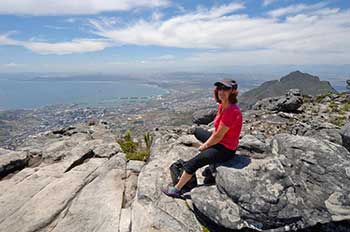 road beckoned. We agreed that anybody would want a week in the Franschoek area, and another around Hermanus, but now we had a five and a half hour haul to Plettenberg Bay. On the way we took a detour, bumping along 50k of wild, bleak dirt road, to Cape Agulhas, which is the southernmost point of Africa. It's an essential snap, of course, and the second oldest lighthouse in South Africa is interesting in itself. And to wander about, peering into rock pools, spending long minutes waiting for a tiny crab to appear, breathing in that bracing air, is peaceful beyond words.
road beckoned. We agreed that anybody would want a week in the Franschoek area, and another around Hermanus, but now we had a five and a half hour haul to Plettenberg Bay. On the way we took a detour, bumping along 50k of wild, bleak dirt road, to Cape Agulhas, which is the southernmost point of Africa. It's an essential snap, of course, and the second oldest lighthouse in South Africa is interesting in itself. And to wander about, peering into rock pools, spending long minutes waiting for a tiny crab to appear, breathing in that bracing air, is peaceful beyond words.
Heading east, past lovely Mossel Bay (great for lunch, looking at the ocean) you reach the Garden Route proper, the landscape becoming much greener and lusher. The climate is milder and wetter than elsewhere (although we had no rain at all) and the hills are clad with magnificent forests. From time to time you come across a tacky development but it isn't as bad as I'd been led to believe, and for a hugely popular tourist area surprisingly uncrowded. With such a punishing schedule we had to pass by places like Knysna,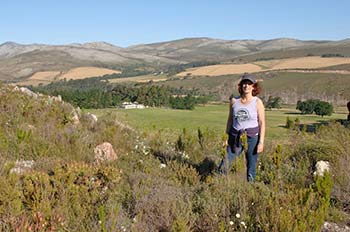 which offer wilderness walks, a lagoon, forest trails, and a whole range of hotels for every pocket. Memo to self: next time allow yourself more holiday time and forget the deadlines. I'd advise everybody to take a slow journey, making time to stop and stare.
which offer wilderness walks, a lagoon, forest trails, and a whole range of hotels for every pocket. Memo to self: next time allow yourself more holiday time and forget the deadlines. I'd advise everybody to take a slow journey, making time to stop and stare.
'Plett' as it's known, is a smart little resort town, combing mountain scenery, white sand and blue water., but after the long drive I was only allowed to dip my toe in the Indian Ocean before we drove another 18k beyond the town itself to find our next hotel. It was to be another delight. Seasoned travellers in South Africa will laugh at me, but I didn't expect such amazing standards of service, accommodation or food on a trip where we had put complete trust in the tour operator. If Le Quartier Francais was chic and the Blue Gum Country Estate was romantic, Hog Hollow proved to be exotic and entertaining.
The hotel consists of a cluster of individual wooden cabins, supported on stilts because of the steep nature of the site. Each one has a terrace – complete with hammock - overlooking the lush, wooden valley where monkeys whoop in the trees. The rooms aren't huge, but are decorated in vibrant colours. For breakfast you walk to the main house and eat a delicious spread on the terrace, watching out for greedy monkeys who sometimes leap down to steal food. And dinner? This was the biggest surprise of all.
When I heard that dining was communal my heart sank. I'm not an unfriendly person but – hey – do you want to sit next to strangers and make conversation? They tell you that if you want a separate table you can ask for one, but on our first night the couple who'd chosen that option looked truly lonely and anti-social. Unwilling as I felt, I knew I had to throw myself into the sprit of the place. Supplied generously with canapés and wine, people stood around the blazing fire basket on the terrace as if it was a cocktail party, so that by the time dinner was called we were all friendly. We all sat where we liked at two long tables. Then comes the amazing Hog Hollow party piece. Each night a different member of the friendly local staff stands for the formal welcome, and introduces each guest by first name in order. How can they remember all the names? An utter mystery, but the round of applause is deserved. And I can honestly say that on both nights the communal dining was really enjoyable (hilarious, actually) – because, after all, since most of us travel in a 'bubble.' it was great to talk to new people: in this case Dutch, German and English.
Next day we devoted to wild-life, but viewed within the easy surroundings of magnificent sanctuaries. 'Monkeyland' and 'Birds of Eden' are a short drive (or very long walk, but one I'm told is beautiful) away, and run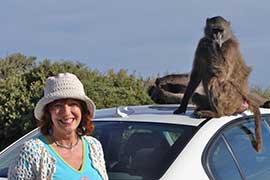 by the same company. Both were fascinating and thrilling in equal measure, because you can get very close to creatures you would never normally see in an environment which is as near to natural as they can make it. But because the monkeys and birds are fed at particular spots they happily chomp away oblivious to who is watching – probably thinking how lucky they are to be living in this particular holiday camp. In Monkeyland you join a (small) group and are walked through the forest by a guide, who points out Capuchins, Vervets, Ring-tailed lemurs, a gibbon he called Claudia Schiffer (why we never discovered!) – and many others. It was utterly enchanting, especially seeing the babies tucked under their mothers' arms or clinging to their backs. And the bird sanctuary was equally wonderful – a vast landscaped area, with wooden walkways and even a mini rainforest under a giant net. We walked through with the bird-spotting booklet, excited to see so many varieties and to get up close and personal with parakeets, one of which tried to steal my watch.
Later we went shopping at three local craft outlets, because it all helps the local economy – or at least, that was my excuse as I piled my purchases into the rental car.
by the same company. Both were fascinating and thrilling in equal measure, because you can get very close to creatures you would never normally see in an environment which is as near to natural as they can make it. But because the monkeys and birds are fed at particular spots they happily chomp away oblivious to who is watching – probably thinking how lucky they are to be living in this particular holiday camp. In Monkeyland you join a (small) group and are walked through the forest by a guide, who points out Capuchins, Vervets, Ring-tailed lemurs, a gibbon he called Claudia Schiffer (why we never discovered!) – and many others. It was utterly enchanting, especially seeing the babies tucked under their mothers' arms or clinging to their backs. And the bird sanctuary was equally wonderful – a vast landscaped area, with wooden walkways and even a mini rainforest under a giant net. We walked through with the bird-spotting booklet, excited to see so many varieties and to get up close and personal with parakeets, one of which tried to steal my watch.
Later we went shopping at three local craft outlets, because it all helps the local economy – or at least, that was my excuse as I piled my purchases into the rental car.
It was to be a day drive back to Cape Town and this time we decided to take the inland route, R62, avoiding the beautiful but crowded coastal road. It was an incredible adventure – a dirt road threading through mostly uninhabited mountains, with dark forests unfolding into bare wild tracts of land, and astonishing distant vistas of mountain peaks layered in shades of grey. At one point we drew up to a troupe of baboons making their way along the deserted road, a couple of babies clinging on fearfully as they heard us and loped off into the undergrowth. Wild and bleak as it was, this landscape felt somehow authentic: far from the tourism of which we were a part. Even when (after a long time) you reach Oudtshoorn, famous for its ostrich farms and therefore a destination, the sleepy town offers only some pleasant ostrich egg artefacts as an inducement to stay.
On and on we drove, through the scrubby edge of the Little Karoo, until at last the land began to green, and there was a glimpse of what looked like vineyards in the distance.
We'd come full circle, or rather full oval – and could easily have slipped into Franschoek for another night of amazing food, but we had a hotel booked in Cape Town so picked up the N32 to bowl back into the city. That night, sitting on our balcony in one of Cape Town's new boutique hotels, Les Cascades, we found ourselves missing the sights and sounds of the countryside at Blue Gum and Hog Hollow. But no matter. We were to have a busy week in South Africa's answer to sunny, laid back Sydney, and suspected that this was just the beginning of a love affair with this beautiful, if troubled, land.
